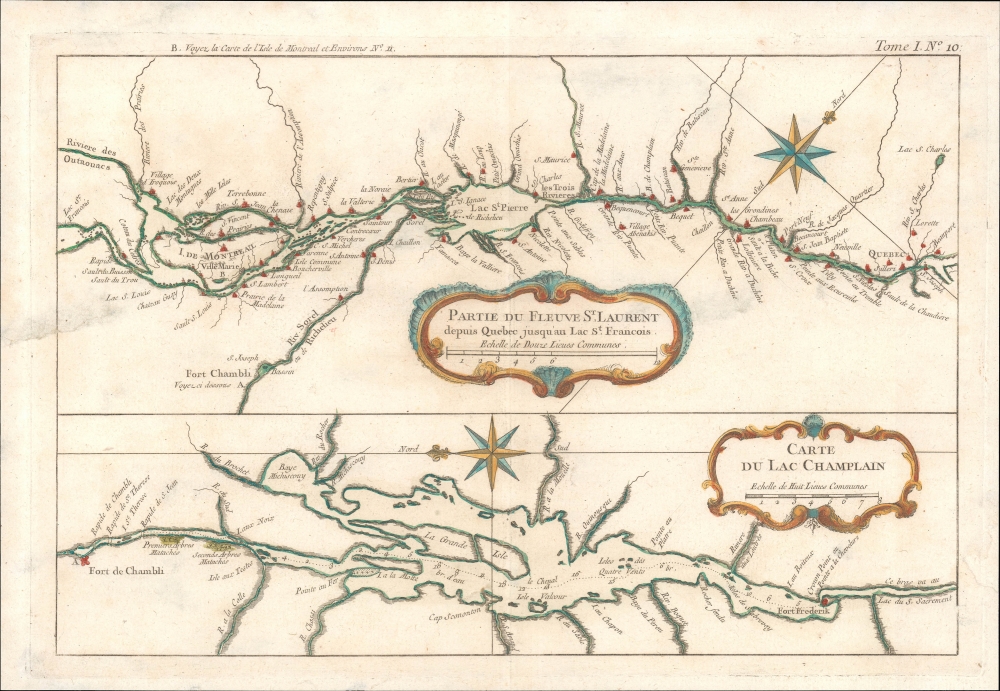This item has been sold, but you can get on the Waitlist to be notified if another example becomes available, or purchase a digital scan.
1764 Bellin Map of the St. Lawrence River, Lake Champlain, and Montreal
StLawrenceLakeChamplain-bellin-1764
Title
1764 (undated) 8.75 x 12.5 in (22.225 x 31.75 cm)
Description
A Closer Look
The sheet is divided in two, with the upper two-thirds consisting of a map of the St. Lawrence River, roughly between Montreal and Quebec City. Settlements, including religious missions, forts, and Native American villages, are illustrated with small buildings and labeled. The St. Lawrence is shaded green, while tributaries are also noted. Tiny crossed swords reluctantly mark the sites of French defeats in the recent war, just north of Quebec City and south of Montreal.The bottom-third of the map, though smaller, is the more significant portion of this sheet, providing a map of Lake Champlain. As above, forts and waterways are noted, while maritime navigational information such as soundings and hazards are indicated on the water. This map is based on French manuscript surveys that Bellin was privy to as the hydrographer to the French crown. Preexisting maps of Lake Champlain were quite rudimentary and inaccurate, and even Bellin's 1744 map of the lake, which was the first accurate map of it to be published, lacked the soundings and some other details present here. Both the French and British surveyed the lake and its surroundings due to its military value during the French and Indian War. Although the larger and more detailed 'Brasier map' of the lake, surveyed by William Brasier and Dietrich Brehm for the British in the late 1750s and early 1760s, was the first accurate, specific map of Lake Champlain published in English (in 1776), this map preceded it by a decade.
French and Indian War
The French and Indian War (1754 - 1763) was the North American extension for the worldwide Seven Years' War (1756 - 1763). It is generally considered distinct from the global conflict due in part to its isolation and in part to the participation of Native American peoples. The war was fought between the British colonies in North America and New France, each supported by Native American allies. Fighting erupted over conflicting claims to the Ohio, Allegheny, and Monongahela River valleys, as well as the Great Lakes. The French believed that their territory extended eastward to the Appalachian Mountains, including all five of the Great Lakes, while the British crown had long made a practice of offering coast-to-coat grants. The French and British were in very different positions at the outbreak of the war. The British controlled the coast and North America's largest cities, with a population of over 2,000,000. The French, on the other hand, controlled Quebec, the Great Lakes, and the Mississippi Valley. Nonetheless, their hegemony in the region was tenuous at best. With less than 60,000 settlers in New France, the French instead relied on close ties with Native American nations. Although they initially won several important victories, the French were ultimately overwhelmed by better-supplied, more numerous British troops and, being occupied in their European war against Prussia, were unwilling to commit further reinforcements. Ultimately, the French surrendered to the British. In the subsequent 1763 Treaty of Paris, France surrendered all of its North American possessions to Great Britain - forever transforming this history of North America.Publication History and Census
This sheet was prepared by Jacques-Nicolas Bellin for the first volume of his Le Petit Atlas Maritime, published in 1764. Due to inconsistent cataloging and the intermingling of physical and digital examples, it is difficult to establish a complete census, but we can confirm that physical examples of the map are independently cataloged with the Library of Congress, University of Michigan, McGill University, Bibliothèque nationale de France, and Biblioteca Nacional de España.Cartographer
Jacques-Nicolas Bellin (1703 - March 21, 1772) was one of the most important cartographers of the 18th century. With a career spanning some 50 years, Bellin is best understood as geographe de cabinet and transitional mapmaker spanning the gap between 18th and early-19th century cartographic styles. His long career as Hydrographer and Ingénieur Hydrographe at the French Dépôt des cartes et plans de la Marine resulted in hundreds of high quality nautical charts of practically everywhere in the world. A true child of the Enlightenment Era, Bellin's work focuses on function and accuracy tending in the process to be less decorative than the earlier 17th and 18th century cartographic work. Unlike many of his contemporaries, Bellin was always careful to cite his references and his scholarly corpus consists of over 1400 articles on geography prepared for Diderot's Encyclopedie. Bellin, despite his extraordinary success, may not have enjoyed his work, which is described as "long, unpleasant, and hard." In addition to numerous maps and charts published during his lifetime, many of Bellin's maps were updated (or not) and published posthumously. He was succeeded as Ingénieur Hydrographe by his student, also a prolific and influential cartographer, Rigobert Bonne. More by this mapmaker...

